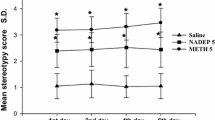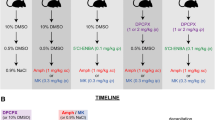Abstract
Experiments were carried out in mice to investigate the influence of diazepam (DZP) on dexamphetamine, para-chloro-N-methylamphetamine (pCMA), cocaine, morphine, trihexyphenidyl or (in MAOIs pretreated) reserpine induced motor hyperactivity.
The interaction of DZP with these hyperactivities in which probably different biochemical central mechanisms are involved allows to construct a profile of action of DZP and to approach its mechanism of action. The locomotor hyperactivities induced by dexamphetamine, pCMA, morphine, cocaine were not reduced by DZP even by doses which decrease spontaneous locomotor activity; low doses of DZP enhance the hyperactivity induced by these compounds. Those induced by trihexyphenidyle or by reserpine (after MAOI) were reduced by DZP at doses which produce no decrease in spontaneous motor activity.
Inasmuch as DZP at low doses potentiates the effects of 4 different substances, the results can hardly be satisfactorily explained neither by an interference of the benzodiazepine on the metabolism of the drugs or by a depression of the anxiogenic action of dexamphetamine.
Even though it may be difficult to relate the antagonism of DZP on trihexyphenidyl- or on reserpine- (after MAOI) induced motor hyperactivity to the suggested anticholinergic and dopaminergic actions of DZP, these effects may partly be involved in the increase in locomotor hyperactivity induced by dexamphetamine, morphine or cocaine.
The observed effect of DZP on pCMA induced locomotor hyperactivity does not support a possible antiserotonine action often suggested to explain the effects of benzodiazepines in conflict situations.
Similar content being viewed by others
Références
Babbini, M., Montanaro, N., Strocchi, P., Gaiardi, M.: Enhancement of amphetamine-induced stereotyped behavior by benzodiazepines. Europ. J. Pharmacol. 13, 330–340 (1971)
Blakely, T. A., Parker, L. F.: The effects of parachlorophenylalanine on experimentally induced conflict behavior. Pharmacol. Biochem. Behav. 1, 609–613 (1973)
Chéramy, A., Gauchy, G., Glowinski, J., Besson, M. J.: In vivo activation by benzotropine of dopamine release and synthesis in the caudate nucleus. Europ. J. Pharmacol. 21, 246–248 (1973)
Christie, J. A., Crow, T. J.: Possible role of dopamine containing neurones in the behavioral effects of cocaÏne. Brit. J. Pharmacol. 42, 643–645 (1971)
Consolo, S., Ladinsky, H., Peri, G., Garattini, S.: Effect of diazepam on mouse whole brain and brain area acetylcholine and choline levels. Europ. J. Pharmacol. 27, 266–268 (1974)
Corrodi, H., Fuxe, K., Lidbrink, P., Olson, L.: Minor tranquillizers, stress and central catecholamine neurones. Brain Res. 29, 1–16 (1971)
Coyle, J. T., Snyder, S. H.: Antiparkinsonian drugs: inhibition of dopamine uptake in the corpus striatum as a possible mechanism of action. Science 166, 899 (1969)
Delini-Stula, A.: Antiexcitatory effects of propranolol and oxprenolol in mice. A pharmacological correlate to their antimanic properties. J. Pharmacol. 5 (suppl. no. 2), 24 (1974)
Frey, H. H., Magnussen, M. P.: Different central mediation of the stimulant effects of amphetamine and its p-chloro analogue. Biochem. Pharmacol. 17, 1299–1307 (1968)
Geller, I., Blum, K.: The effect of 5-HTP on para-chlorophenylalanine (p-CPA) attenuation on “conflict” behavior. Europ. J. Pharmacol. 9, 319–324 (1970)
Geller, I., Hartman, R. J., Croy, D. J., Haber, B.: Attenuation of conflict behavior with cinanserin, a serotonin antagonist: reversal of the effect with 5-hydroxy-tryptophan and alpha-methyltryptamine. Res. Comm. chem. Path. Pharmacol. 7, 165–174 (1974)
Javoy, F., Agid, Y., Bouvet, D., Glowinski, J.: Changes in neostriatal DA metabolism after carbachol or atropine microinjections into the substantia nigra. Brain Res. 68, 253–260 (1974)
Kuschinsky, K., Hornykiewicz, O.: Effects of morphine on striatal dopamine metabolism: possible mechanism of its opposite effect on locomotor activity in rats and mice. Europ. J. Pharmacol. 26, 41–50 (1974)
Lidbrink, P., Corrodi, H., Fuxe, K., Olson, L.: The effects of benzodiazepines, meprobamate and barbiturates on central monoamine neurones. The benzodiazepines, S. Garattini et al., ed., pp. 203–223. New York: Raven Press 1973
Malatray, J., Simon, P.: Effets ≪psychotropes≫ de quelques antiparkinsoniens. Etude chez l'animal. J. Pharmacol. (Paris) 3, 325–342 (1972)
Margules, D. L., Stein, L.: Neuroleptics vs tranquilizers: evidence from animal behavior studies of mode of action. Neuropsychopharmacology, Int. Congr., no. 5 (Washington), pp. 108–120 (1967)
Parker, R. B.: Mouse locomotor activity: effect of morphine, narcotic antagonists, and the interaction of morphine and narcotic antagonists. Psychopharmacologia (Berl.) 38, 15–23 (1974)
Rushton, R., Steinberg, H.: Drug combination and their analysis by means of exploratory activity in rats. Neuropsychopharmacology, Int. Congr. no. 5 (Washington), pp. 464–470 (1967)
Sethy, V. H., Naik, P. Y., Sheth, U. K.: Effect of d-amphetamine sulfate in combination with CNS depressants on spontaneous motor activity of mice. Psychopharmacologia (Berl.) 18, 19–25 (1970)
Simon, P., Larousse, C., Boissier, J. R.: Troubles du comportement provoqués par l'amphétamine chez l'Animal. Leur utilisation comme ≪modèles≫. Atti. III. Riunione Nazionale Societa Italiana di Neuropsicofarmacologia. La farmacoterapia nella schizofrenia, pp. 49–66 (1970a). Milan: Pacioni Mariotti, Pisa Ed.
Simon, P., Soubrié, P., Boissier, J. R.: Hyperactivité motrice induite chez la souris par un anticholinergique central. Antagonisme par les benzodiazépines. J. Pharmacol., no. 5 (suppl. no. 2), p. 93 (1974)
Simon, P., Tillement, J. P., Larousse, C., BrÊteau, M., Guernet, M., Boissier, J. R.: Effets pharmacologiques et biochimiques comparés de l'amphétamine et de la p-chloro-N-méthyl-amphétamine. J. Pharmacol. (Paris) 1, 95–108 (1970b)
Smith, C. B., Sheldon, M. I., Bednarczyk, J. H., Villarreal, J. E.: Morphine-induced increases in the incorporation of 14C-tyrosine into 14C-dopamine and 14C-norepinephrine into the mouse brain: antagonism by naloxone and tolerance. J. Pharmacol. exp. Ther. 180, 547–557 (1972)
Svensson, T. H.: The effect of inhibition of catecholamine synthesis on dexamphetamine induced central stimulation. Europ. Europ. J. Pharmacol. 12, 161–166 (1970)
Winter, J. C.: Comparison of chlordiazepoxide, methysergide and cinanserin as modifiers of punished behavior and as antagonists of N,N-dimethyltryptamine. Arch. int. Pharmacodyn. 197, 147–159 (1972)
Author information
Authors and Affiliations
Rights and permissions
About this article
Cite this article
Soubrié, P., Simon, P. & Boissier, J.R. Effets du diazépam sur six modèles d'hyperactivité chez la souris. Psychopharmacologia 45, 197–201 (1975). https://doi.org/10.1007/BF00429061
Received:
Revised:
Issue Date:
DOI: https://doi.org/10.1007/BF00429061




